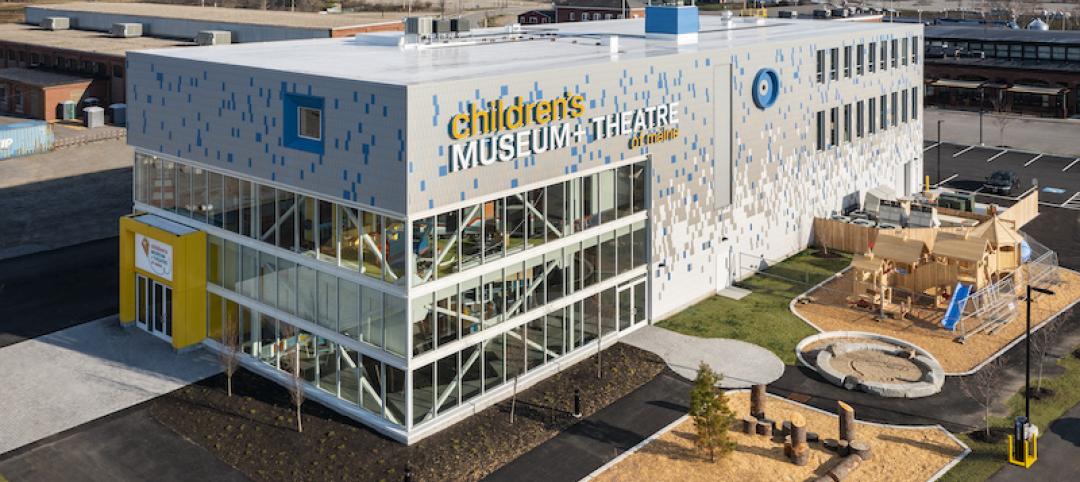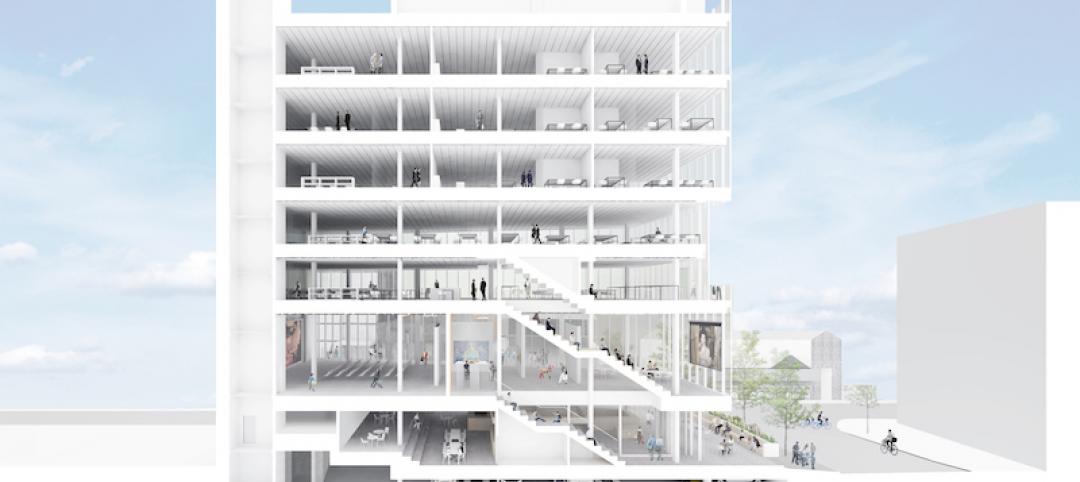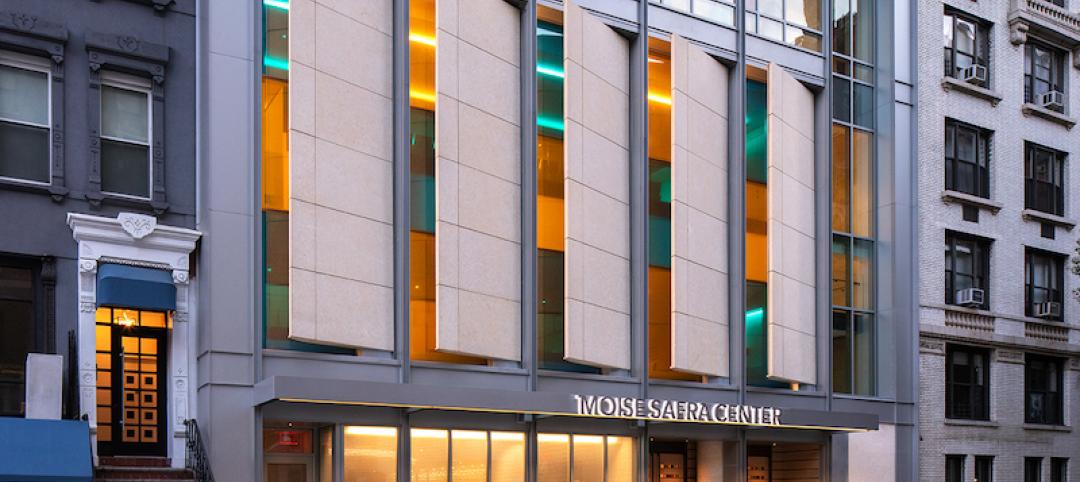
Through a unique partnership between a public media organization and a performing arts/education entity, a historic building in the heart of downtown Cleveland has been renovated as a model of sustainability and architectural innovation.
 |
| PHOTO: KEVIN REEVES PHOTOGRAPHY |
Playhouse Square, which had been working for more than 30 years to revitalize the city's arts district, teamed up with ideastream, a newly formed media group that combined public TV station WVIZ/PBS and FM radio station WCPN, to create a novel, inventive space for the performing arts, education programs, and radio broadcasting, as well as leased office space.
Local A/E firm Westlake Reed Leskosky (WRL) and the Cleveland office of URS Corp. got to work integrating a trendy, open design—and one that would save energy—into the existing structure.
The facility's main architectural feature is its transparency and openness, which exposes the center's cultural and educational activities to downtown Cleveland traffic. Restoring the storefront created “a simple, clean opening” to the activity within the center for passersby, notes Christopher Diehl, AIA, URS's VP and director of design.
Starting with the building's entry, an inverted canopy was designed to welcome visitors into a glass-enclosed vestibule where dance and broadcast/recording studios are easily visible. Colored cables, electronics, motors, and sound and light systems are exposed to add to the excitement of a backstage studio environment. The entry vestibule guides visitors to the historic lobby, with its ornamental staircase leading to a mezzanine, with its restored balustrade and new glass floor.
 |
| Floor-to-ceiling glass walls put the facility’s dance and broadcast/recording studios on display, adding to the vibrancy of the interior space. PHOTO: KEVIN REEVES PHOTOGRAPHY |
“The existing mezzanine landing was a dark and oppressive form overhead as one entered the lobby,” says Diehl. “We felt it was critical to the entry and journey experience to remove the brooding heaviness overhead, and open up the landing on both sides. The result is a space that feels much lighter and one that allows the activity to be viewed on all sides.”
Further inside, activities on multiple floors are connected, physically and visually, through deep wells and stairways cut into the building. Large windows, designed according to the size, proportion, and geometry of the original windows, take advantage of federal Historic Rehabilitation Tax Credits.
Robert L. Selby, FAIA, associate professor, School of Architecture, University of Illinois at Urbana-Champaign, commends the project for its sense of openness. “I like the way it gives high visibility to the arts,” he says.
Adding to the culturally vibrancy of the building is a state-of-the-art, 300-seat production theater, a new construction suspended over an existing loading dock and service alley. Featuring a collapsible, portable seating system, as well as customized floor construction and dual lighting to support both television and theatrical productions, the black-box space posed unique structural challenges.
Westlake Reed Leskosky, serving also as structural engineer, took the approach of maintaining the load path from the existing floor plate and columns to the foundations of the existing concrete structure. This eliminated the need to remove the first- and second-floor interior columns and floor slabs, or to redirect load transfer to the foundations; it also made it possible to suspend the new theater from the existing structure, with minimal new columns underneath, in order to maintain vehicle circulation underneath the studio.
Beyond the technical details, the real brilliance of the new theater is the efficiencies captured by space sharing.
“Playhouse Square needed a theater, ideastream needed a media studio, and both organizations have an educational mission,” notes Kathryn P. Jensen, ideastream's COO. “By integrating the two purposes, we saved what would have separately cost us $7 million.”
Having multiple high-tech tenants in a building will often create waste, because each wants to maintain separate systems for power distribution, heating and cooling, and other basic components, notes WRL associate and mechanical engineer Matthew Murphy, PE. With its central plant and shared systems and infrastructure, Idea Center creates architectural and engineering synergies that lead to lower operating costs and higher efficiency. The project earned a Silver rating under the U.S. Green Building Council's LEED-CI (commercial interiors) program.
To support the radio stations and high-tech tenants, the facility houses a robust and redundant power distribution, UPS backup, and ground and standby generator systems. EMI shielding protects the sensitive high-frequency communication cables from magnetic fields emitted by the distribution systems.
To meet high acoustical requirements (NC-15, as opposed to NC 40-45 for typical offices), motorized equipment and transformers are isolated, cooling equipment is sited in a remote location, distribution ductwork is lined with acoustical material, and ductwork distribution pathways are designed in large sections with circuitous routes to allow for noise dissipation and lower velocity airflow.
The true success of the Idea Center, however, is the vibrancy it is contributing to the Playhouse Square district. As lead designer Paul E. Westlake, Jr., FAIA, put it, “The fabric woven here is the cloth of community culture.”
Related Stories
Giants 400 | Aug 30, 2021
2021 Giants 400 Report: Ranking the largest architecture, engineering, and construction firms in the U.S.
The 2021 Giants 400 Report includes more than 130 rankings across 25 building sectors and specialty categories.
Resiliency | Aug 19, 2021
White paper outlines cost-effective flood protection approaches for building owners
A new white paper from Walter P Moore offers an in-depth review of the flood protection process and proven approaches.
Cultural Facilities | Aug 2, 2021
A new venue for the San Diego Symphony’s outdoor performances opens this week
Rady Shell at Jacobs Park was funded almost entirely by private donors.
Cultural Facilities | Jun 28, 2021
Maine’s Children’s Museum & Theatre moves into new location that doubles its size
Interactive exhibits are among its features.
Resiliency | Jun 24, 2021
Oceanographer John Englander talks resiliency and buildings [new on HorizonTV]
New on HorizonTV, oceanographer John Englander discusses his latest book, which warns that, regardless of resilience efforts, sea levels will rise by meters in the coming decades. Adaptation, he says, is the key to future building design and construction.
Multifamily Housing | Jun 3, 2021
Student Housing Trends 2021-2022
In this exclusive video interview for HorizonTV, Fred Pierce, CEO of Pierce Education Properties, developer and manager of off-campus student residences, chats with Rob Cassidy, Editor, MULTIFAMILY Design + Construction about student housing during the pandemic and what to expect for on-campus and off-campus housing in Fall 2021 and into 2022.
Digital Twin | May 24, 2021
Digital twin’s value propositions for the built environment, explained
Ernst & Young’s white paper makes its cases for the technology’s myriad benefits.
Wood | May 14, 2021
What's next for mass timber design?
An architect who has worked on some of the nation's largest and most significant mass timber construction projects shares his thoughts on the latest design trends and innovations in mass timber.
Cultural Facilities | Apr 1, 2021
A Connecticut firm deploys design to assist underserved people and communities
Hartford, Conn.-based JCJ Architecture traces its roots to 1936, when the U.S. was just coming out of an economic depression and its unemployment rate was still 14%. In 2021, with the country trying to recover economically from the impact of the coronavirus, and with questions about social inequity entering the public debate as rarely before, JCJ has focused its design work on projects and clients that are committed to social responsibility and advocacy, particularly for underserved or marginalized communities.
Cultural Facilities | Mar 1, 2021
Moise Safra Center completes in New York City
The project will act as a second home for the Jewish community it serves.






![Oceanographer John Englander talks resiliency and buildings [new on HorizonTV] Oceanographer John Englander talks resiliency and buildings [new on HorizonTV]](/sites/default/files/styles/list_big/public/Oceanographer%20John%20Englander%20Talks%20Resiliency%20and%20Buildings%20YT%20new_0.jpg?itok=enJ1TWJ8)









